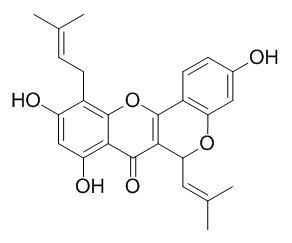Cyclomulberrin
Cyclomulberrin shows strong inhibition of arachidonic acid (AA)- and collagen-induced platelet aggregation, it also shows slight but significant antiplatelet effects on the aggregation induced by PAF. Cyclomulberrin enhances cell viability in a dose-dependent manner against sodium nitroprusside-induced cell death in neuroblastoma SH-SY5Y cells. It exhibits potent inhibition of human PLC/PRF/5 and KB cells in-vitro.
Inquire / Order:
manager@chemfaces.com
Technical Inquiries:
service@chemfaces.com
Tel:
+86-27-84237783
Fax:
+86-27-84254680
Address:
1 Building, No. 83, CheCheng Rd., Wuhan Economic and Technological Development Zone, Wuhan, Hubei 430056, PRC
Providing storage is as stated on the product vial and the vial is kept tightly sealed, the product can be stored for up to
24 months(2-8C).
Wherever possible, you should prepare and use solutions on the same day. However, if you need to make up stock solutions in advance, we recommend that you store the solution as aliquots in tightly sealed vials at -20C. Generally, these will be useable for up to two weeks. Before use, and prior to opening the vial we recommend that you allow your product to equilibrate to room temperature for at least 1 hour.
Need more advice on solubility, usage and handling? Please email to: service@chemfaces.com
The packaging of the product may have turned upside down during transportation, resulting in the natural compounds adhering to the neck or cap of the vial. take the vial out of its packaging and gently shake to let the compounds fall to the bottom of the vial. for liquid products, centrifuge at 200-500 RPM to gather the liquid at the bottom of the vial. try to avoid loss or contamination during handling.
J Agric Food Chem.2020, 68(51):15164-15175
J Food Drug Anal.2023, 31(2):254-277.
South African Journal of Botany2024, 168:209-220.
Molecules.2023, 28(13):4971.
Sichuan Agricultural University2023, 4630743.
Universiti Tunku Aboul Rahman2023, 6263.
J Mater Chem B.2019, 7(39):5896-5919
Front Plant Sci.2024, 15:1458916.
Pharmacogn Mag.2015, 11(43):562-6
Food Hydrocolloids2024, 156:110345
Related and Featured Products
Arch Pharm Res. 2012 Jan;35(1):163-70.
Protection of prenylated flavonoids from Mori Cortex Radicis (Moraceae) against nitric oxide-induced cell death in neuroblastoma SH-SY5Y cells.[Pubmed:
22297755]
METHODS AND RESULTS:
Seven prenylated flavanoids, licoflavone C (1), Cyclomulberrin (2), neocyclomorusin (3), sanggenon I (4), morusin (5), kuwanon U (6) and kuwanon E (7), and three 2-arylbenzofurans, moracin P (8), moracin O (9), and mulberrofuran Q (10) were isolated from the MeOH extract of Mori Cortex Radicis. Among these, compounds 2-7 enhanced cell viability in a dose-dependent manner against sodium nitroprusside-induced cell death in neuroblastoma SH-SY5Y cells, which was measured by MTT reduction assay (EC(50) values of 4.4, 5.6, 8.0, 6.4, 8.7, and 11.9 μg/mL, respectively). Among 10 compounds, C-3 prenylated flavones (2, 3, and 5) and prenylated flavanones (4, 6, and 7) showed cell protection. However, compound 1 which lacks the prenyl group at C-3 and three 2-arylbenzofurans (8-10) did not show protective effect. The order of cell protection was as follow: C-3 prenylated flavones (2, 3, and 5) > prenylated flavanones (4, 6, and 7) > 2-arylbenzofurans (8-10) and flavone (1).
CONCLUSIONS:
From this result, we show that some prenylated flavones and flavanones might protect neuronal cells against nitrosative stress-mediated cell death.
Even though further evaluations are necessary in vitro and in vivo study, we carefully suggest that some prenylated flavonoids from Mori Cortex Radicis might protect neuronal cells from neurodegenerative diseases.
Biochem Pharmacol. 1993 Jan 26;45(2):509-12.
Antiplatelet activity of some prenylflavonoids.[Pubmed:
8435100]
Eight naturally occurring prenylflavonoids were tested for their antiplatelet activities in rabbit platelet suspension.
METHODS AND RESULTS:
Cyclomorusin and artomunoxanthone showed strong inhibition of platelet-activating factor (PAF; 1-O-alkyl-2-acetyl-sn-glycero-3-phosphocholine) induced platelet aggregation. Cyclomulberrin, dihydroisocycloartomunin, cyclocommunol and cyclocommunin showed strong inhibition of arachidonic acid (AA)- and collagen-induced platelet aggregation. Cyclomorusin also inhibited markedly collagen-induced platelet aggregation. Cyclocommunin, dihydroisocycloartomunin and Cyclomulberrin also showed slight but significant antiplatelet effects on the aggregation induced by PAF.
CONCLUSIONS:
Of the compounds tested, cyclocommunin exhibited the most potent inhibition of platelet aggregation induced by collagen (IC50 = 14.4 microM) and AA (IC50 = 12.5 microM). Thromboxane B2 formation caused by AA was suppressed by cyclocommunin and artomunoxanthone.
J Pharm Pharmacol. 1993 Sep;45(9):791-4.
Gamma-pyrone compounds as potential anti-cancer drugs.[Pubmed:
7903365]
METHODS AND RESULTS:
The gamma-pyrones, artomunoxanthotrione epoxide, cyclocommunol, Cyclomulberrin, and cyclocommunin exhibited potent inhibition of human PLC/PRF/5 and KB cells in-vitro. Dihydroisocycloartomunin showed significant and potent inhibition of human PLC/PRF/5 and KB cells in-vitro, respectively. Cyclomorusin, dihydrocycloartomunin and artomunoxanthone showed significant inhibition of KB cells in-vitro. Based on the above finding and the reported antileukaemic activity of xanthone psorospermin, a series of natural gamma-pyrones was prepared and the inhibition of human PLC/PRF/5 and KB cells in-vitro was measured.
CONCLUSIONS:
Structure-activity analysis indicated the epoxide group substituted at 3-hydroxyl and 2,6-; 3,6-; and 3,5-dihydroxyl xanthone enhanced the anti-tumour activity. The epoxide group substituted at the 6-hydroxyl group of 1,6-dihydroxyxanthone did not show anti-tumour activity.



